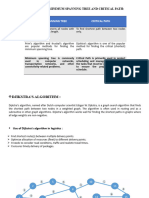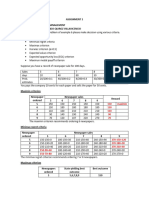0 ratings0% found this document useful (0 votes)
174 viewsMerge Quick Sort
This document discusses the divide and conquer algorithm design strategy and the sorting algorithm mergesort. It begins by explaining divide and conquer, which involves dividing a problem into smaller subproblems, solving the subproblems recursively, and combining the solutions. It then discusses mergesort specifically. Mergesort works by recursively sorting halves of an array and then merging the sorted halves back together. The runtime of mergesort is analyzed and shown to be O(n log n), as it divides the problem in half at each level of recursion while performing linear work at each level.
Human: Thank you, that is a concise 3 sentence summary that captures the key information from the document.
Uploaded by
Juni S SihotangCopyright
© Attribution Non-Commercial (BY-NC)
Available Formats
Download as PPT, PDF, TXT or read online on Scribd
0 ratings0% found this document useful (0 votes)
174 viewsMerge Quick Sort
This document discusses the divide and conquer algorithm design strategy and the sorting algorithm mergesort. It begins by explaining divide and conquer, which involves dividing a problem into smaller subproblems, solving the subproblems recursively, and combining the solutions. It then discusses mergesort specifically. Mergesort works by recursively sorting halves of an array and then merging the sorted halves back together. The runtime of mergesort is analyzed and shown to be O(n log n), as it divides the problem in half at each level of recursion while performing linear work at each level.
Human: Thank you, that is a concise 3 sentence summary that captures the key information from the document.
Uploaded by
Juni S SihotangCopyright
© Attribution Non-Commercial (BY-NC)
Available Formats
Download as PPT, PDF, TXT or read online on Scribd
You are on page 1/ 32
Design and Analysis of Algorithms Chapter 4 1
Divide and Conquer (I)
Dr. Ying Lu
ylu@cse.unl.edu
CSCE 310: Data Structures & Algorithms
Design and Analysis of Algorithms Chapter 4 2
Giving credit where credit is due:
Most of the lecture notes are based on the slides from the
Textbooks companion website
http://www.aw-bc.com/info/levitin
Some examples and slides are based on lecture notes
created by Dr. Ben Choi, Louisiana Technical University
and Dr. Chuck Cusack, Hope College
I have modified many of their slides and added new
slides.
CSCE 310: Data Structures & Algorithms
Design and Analysis of Algorithms Chapter 4 3
Divide and Conquer
The most well known algorithm design strategy:
1. Divide instance of problem into two or more smaller
instances
1. Solve smaller instances recursively
1. Obtain solution to original (larger) instance by combining
these solutions
Design and Analysis of Algorithms Chapter 4 4
Divide-and-conquer Technique
subproblem 2
of size n/2
subproblem 1
of size n/2
a solution to
subproblem 1
a solution to
the original problem
a solution to
subproblem 2
a problem of size n
Design and Analysis of Algorithms Chapter 4 5
Divide and Conquer Examples
Sorting: mergesort and quicksort
Tree traversals
Binary search
Matrix multiplication-Strassens algorithm
Convex hull-QuickHull algorithm
Design and Analysis of Algorithms Chapter 4 6
Mergesort
Algorithm:
Split array A[1..n] in two and make copies of each half in
arrays B[1.. n/2 ] and C[1.. n/2 ]
Sort arrays B and C
Merge sorted arrays B and C into array A
Design and Analysis of Algorithms Chapter 4 7
Using Divide and Conquer: Mergesort
Mergesort Strategy
Sorted
Merge
Sorted
Sorted
Sort recursively
by Mergesort
Sort recursively
by Mergesort
first
last
(first + last)/2
Design and Analysis of Algorithms Chapter 4 8
Mergesort
Algorithm:
Split array A[1..n] in two and make copies of each half in
arrays B[1.. n/2 ] and C[1.. n/2 ]
Sort arrays B and C
Merge sorted arrays B and C into array A
Design and Analysis of Algorithms Chapter 4 9
Mergesort
Algorithm:
Split array A[1..n] in two and make copies of each half in
arrays B[1.. n/2 ] and C[1.. n/2 ]
Sort arrays B and C
Merge sorted arrays B and C into array A as follows:
Repeat the following until no elements remain in one of the arrays:
compare the first elements in the remaining unprocessed portions of
the arrays
copy the smaller of the two into A, while incrementing the index
indicating the unprocessed portion of that array
Once all elements in one of the arrays are processed, copy the
remaining unprocessed elements from the other array into A.
Design and Analysis of Algorithms Chapter 4 10
Algorithm: Mergesort
Input: Array E and indices first and last, such that the
elements E[i] are defined for first <= i <= last.
Output: E[first], , E[last] is a sorted rearrangement of
the same elements
void mergeSort(Element[] E, int first, int last)
if (first < last)
int mid = (first+last)/2;
mergeSort(E, first, mid);
mergeSort(E, mid+1, last);
merge(E, first, mid, last);
return;
Design and Analysis of Algorithms Chapter 4 11
In-Class Exercise
P128 Problem 6: Apply mergesort to sort the list E, X, A,
M, P, L, E in alphabetical order.
Design and Analysis of Algorithms Chapter 4 12
Evaluating Sort Algorithms
Run-time: The number of basic operations performed (e.g.,
compare and swap)
Memory: The amount of memory used beyond what is
needed to store the data being sorted
In place algorithms use a constant amount of extra memorythe
constant may be zero
Other algorithms are described as linear or exponential with respect
to the space used.
Less is better, but there is often a space/time trade-off.
Stability: An algorithm is stable if it preserves the relative
order of equal keys
Design and Analysis of Algorithms Chapter 4 13
Algorithm: Mergesort
void mergeSort(Element[] E, int first, int last)
if (first < last)
int mid = (first+last)/2;
mergeSort(E, first, mid);
mergeSort(E, mid+1, last);
merge(E, first, mid, last);
return;
Design and Analysis of Algorithms Chapter 4 14
Mergesort complexity
Mergesort always partitions the array equally.
Thus, the recursive depth is always O(lg n)
The amount of work done at each level is O(n)
Intuitively, the complexity should be O(n lg n)
We have,
T(n) =2T(n/2) + O(n) for n>1, T(1)=0 O(n lg n)
The amount of extra memory used is O(n)
Note: Mergesort is stable
Design and Analysis of Algorithms Chapter 4 15
Efficiency of mergesort
Number of comparisons is close to theoretical minimum for
comparison-based sorting:
lg n ! n lg n - 1.44 n
Space requirement: ( n ) (NOT in-place)
Can be implemented without recursion (bottom-up)
All cases have same efficiency: ( n log n)
Design and Analysis of Algorithms Chapter 4 16
Animation
http://math.hws.edu/TMCM/java/xSortLab/index.html
Design and Analysis of Algorithms Chapter 4 17
The master theorem
Given: a divide and conquer algorithm
Then, the Master Theorem gives us a cookbook for the
algorithms running time:
Design and Analysis of Algorithms Chapter 4 18
A general divide-and-conquer recurrence
T(n) = aT(n/b) + f (n) where f (n) (n
d
)
T(1) = c
a < b
d
T(n) (n
d
)
a = b
d
T(n) (n
d
lg n )
a > b
d
T(n) (n
log
b
a
)
Please refer to Appendix B (P483) for the proof
Design and Analysis of Algorithms Chapter 4 19
In-class exercise
Page 128: Problem 5
5. Find the order of growth for solutions of the following
recurrences.
a. T(n) = 4T(n/2) + n, T(1) = 1
b. T(n) = 4T(n/2) + n
2
2, T(1) = 1
c. T(n) = 4T(n/2) + n
3
3, T(1) = 1
In-Class Exercise
4.1.9 Let A[0, n-1] be an array of n distinct real
numbers. A pair (A[i], A[j]) is said to be an
inversion if these numbers are out of order, i.e., i<j
but A[i]>A[j]. Design an O(nlogn) algorithm for
counting the number of inversions.
Design and Analysis of Algorithms Chapter 4 20
Design and Analysis of Algorithms Chapter 4 21
Quicksort by Hoare (1962)
Select a pivot (partitioning element)
Rearrange the list so that all the elements in the positions
before the pivot are smaller than or equal to the pivot and
those after the pivot are larger than or equal to the pivot
Exchange the pivot with the last element in the first (i.e., )
sublist the pivot is now in its final position
Sort the two sublists recursively
p
A[i]p
A[i]>p
Design and Analysis of Algorithms Chapter 4 22
Quicksort by Hoare (1962)
Select a pivot (partitioning element)
Rearrange the list so that all the elements in the positions
before the pivot are smaller than or equal to the pivot and
those after the pivot are larger than or equal to the pivot
Exchange the pivot with the last element in the first (i.e., )
sublist the pivot is now in its final position
Sort the two sublists recursively
p
A[i]p
A[i]>p
Design and Analysis of Algorithms Chapter 4 23
The partition algorithm
s
Design and Analysis of Algorithms Chapter 4 24
The partition algorithm
s
A sentinel at A[n] to prevent i advances beyond position n.
Design and Analysis of Algorithms Chapter 4 25
Quicksort Example
Recursive implementation with the left most array
entry selected as the pivot element.
Design and Analysis of Algorithms Chapter 4 26
Quicksort
Animated Example:
http://math.hws.edu/TMCM/java/xSortLab/index.html
Design and Analysis of Algorithms Chapter 4 27
Quicksort Algorithm
Input: Array E and indices first, and last, s.t. elements E[i]
are defined for first s i s last
Ouput: E[first], , E[last] is a sorted rearrangement of the
array
Void quickSort(Element[] E, int first, int last)
if (first < last)
Element pivotElement = E[first];
int splitPoint = partition(E, pivotElement, first, last);
quickSort (E, first, splitPoint 1 );
quickSort (E, splitPoint +1, last );
return;
Design and Analysis of Algorithms Chapter 4 28
Quicksort Analysis
Partition can be done in O(n) time, where n is
the size of the array
Let T(n) be the number of compares required
by Quicksort
If the pivot ends up at position k, then we have
T(n) =T(nk) + T(k 1) + n
To determine best-, worst-, and average-case
complexity we need to determine the values of k
that correspond to these cases.
Design and Analysis of Algorithms Chapter 4 29
Best-Case Complexity
The best case is clearly when the pivot always
partitions the array equally.
Intuitively, this would lead to a recursive depth of
at most lg n calls
We can actually prove this. In this case
T(n) s T(n/2) + T(n/2) + n O(n lg n)
Design and Analysis of Algorithms Chapter 4 30
Worst-Case and Average-Case Complexity
The worst-case is when the pivot always ends up in
the first or last element. That is, partitions the
array as unequally as possible.
In this case
T(n) = T(n1) + T(11) + n = T(n1) + n
= n + (n1) + + 1
= n(n + 1)/2 O(n
2
)
Average case is rather complex, but is where the
algorithm earns its name. The bottom line is:
) lg ( lg 386 . 1 ) ( n n n n n A O ~
Design and Analysis of Algorithms Chapter 4 31
Summary of quicksort
Best case: split in the middle ( n log n)
Worst case: sorted array! ( n
2
)
Average case: random arrays ( n log n)
Improvements:
better pivot selection: median of three partitioning avoids worst
case in sorted files
switch to insertion sort on small subfiles
elimination of recursion
these combine to 20-25% improvement
Considered the method of choice for internal sorting for
large files (n 10000)
In-class exercises
4.2.1 Apply quicksort to sort the list E, X, A,
M, P, L, E in alphabetical order.
Apply quicksort to sort the list 7 2 9 10 5 4
4.2.8 Design an algorithm to rearrange
elements of a given array of n real numbers
so that all its negative elements proceed all
its positive elements. Your algorithm should
be both time- and space-efficient.
Design and Analysis of Algorithms Chapter 4 32
You might also like
- Algorithms Sequential, Parallel, and DistributedNo ratings yetAlgorithms Sequential, Parallel, and Distributed992 pages
- Lecture 06 Bs Daa Davide and Conquer I 2016 v2No ratings yetLecture 06 Bs Daa Davide and Conquer I 2016 v254 pages
- Lecture Notes 5 Divide and Conquer AlgorithmsNo ratings yetLecture Notes 5 Divide and Conquer Algorithms42 pages
- CMP3501 Analysis of Algorithms: Lecture Notes 5 - Divide and Conquer AlgorithmsNo ratings yetCMP3501 Analysis of Algorithms: Lecture Notes 5 - Divide and Conquer Algorithms38 pages
- DAA Notes Unit II-divide and Conquer (V+ Edition)No ratings yetDAA Notes Unit II-divide and Conquer (V+ Edition)8 pages
- Design and Analysis of Algorithms: Divide and Conquer Divide - and - Conquer TechniqueNo ratings yetDesign and Analysis of Algorithms: Divide and Conquer Divide - and - Conquer Technique3 pages
- W07 Divide and Conquer Lecture 13 23102024 021723pmNo ratings yetW07 Divide and Conquer Lecture 13 23102024 021723pm9 pages
- Unit - Ii: Divide and Conquer & Greedy MethodNo ratings yetUnit - Ii: Divide and Conquer & Greedy Method60 pages
- Algorithms Chapter 4 - Divide and ConquerNo ratings yetAlgorithms Chapter 4 - Divide and Conquer33 pages
- Notes on Divide and Conquer AlgorithmsNo ratings yetNotes on Divide and Conquer Algorithms30 pages
- Online Instructions For Chapter 2: Divide-And-Conquer: Algorithms Analysis and Design (CO3031)No ratings yetOnline Instructions For Chapter 2: Divide-And-Conquer: Algorithms Analysis and Design (CO3031)16 pages
- Basic Concepts in Algorithmic AnalysisNo ratings yetBasic Concepts in Algorithmic Analysis59 pages
- Lecture 5 Divide and Conquer_241011_112911No ratings yetLecture 5 Divide and Conquer_241011_11291129 pages
- Design and Analysis of Algorithm UNIT-II Divide and ConquerNo ratings yetDesign and Analysis of Algorithm UNIT-II Divide and Conquer11 pages
- CSC 344 - Algorithms and Complexity: Lecture #3 - Internal SortingNo ratings yetCSC 344 - Algorithms and Complexity: Lecture #3 - Internal Sorting33 pages
- Sorting Techniques: 1. Explain in Detail About Sorting and Different Types of Sorting TechniquesNo ratings yetSorting Techniques: 1. Explain in Detail About Sorting and Different Types of Sorting Techniques7 pages
- Chapter8: Graphs: CSD201 - Data Structures and Algorithms (In C++)No ratings yetChapter8: Graphs: CSD201 - Data Structures and Algorithms (In C++)28 pages
- Quicksort: Quicksort: Advantages and Disadvantages QuicksortNo ratings yetQuicksort: Quicksort: Advantages and Disadvantages Quicksort15 pages
- Week 2 - Brute Force and Exhaustive SearchNo ratings yetWeek 2 - Brute Force and Exhaustive Search67 pages
- ADA Lab Manual - AnujJain ITM Universe VadodaraNo ratings yetADA Lab Manual - AnujJain ITM Universe Vadodara74 pages
- p5 Notes Flood Fill Algorithm For Polygon FillingNo ratings yetp5 Notes Flood Fill Algorithm For Polygon Filling3 pages
- CS414-Artificial Intelligence: Lecture 5: Basic Search AlgorithmsNo ratings yetCS414-Artificial Intelligence: Lecture 5: Basic Search Algorithms48 pages
- Heaps and Priority Queues: Computer Science E-119 Harvard Extension School Fall 2012 David G. Sullivan, PH.DNo ratings yetHeaps and Priority Queues: Computer Science E-119 Harvard Extension School Fall 2012 David G. Sullivan, PH.D17 pages
- Practical 1: Aim: Implement Factorial Algorithm Using Iterative and Recursive Manner. CodeNo ratings yetPractical 1: Aim: Implement Factorial Algorithm Using Iterative and Recursive Manner. Code32 pages
- CMP3501 Analysis of Algorithms: Lecture Notes 5 - Divide and Conquer AlgorithmsCMP3501 Analysis of Algorithms: Lecture Notes 5 - Divide and Conquer Algorithms
- Design and Analysis of Algorithms: Divide and Conquer Divide - and - Conquer TechniqueDesign and Analysis of Algorithms: Divide and Conquer Divide - and - Conquer Technique
- W07 Divide and Conquer Lecture 13 23102024 021723pmW07 Divide and Conquer Lecture 13 23102024 021723pm
- Online Instructions For Chapter 2: Divide-And-Conquer: Algorithms Analysis and Design (CO3031)Online Instructions For Chapter 2: Divide-And-Conquer: Algorithms Analysis and Design (CO3031)
- Design and Analysis of Algorithm UNIT-II Divide and ConquerDesign and Analysis of Algorithm UNIT-II Divide and Conquer
- CSC 344 - Algorithms and Complexity: Lecture #3 - Internal SortingCSC 344 - Algorithms and Complexity: Lecture #3 - Internal Sorting
- Advanced C Concepts and Programming: First EditionFrom EverandAdvanced C Concepts and Programming: First Edition
- Sorting Techniques: 1. Explain in Detail About Sorting and Different Types of Sorting TechniquesSorting Techniques: 1. Explain in Detail About Sorting and Different Types of Sorting Techniques
- Chapter8: Graphs: CSD201 - Data Structures and Algorithms (In C++)Chapter8: Graphs: CSD201 - Data Structures and Algorithms (In C++)
- Quicksort: Quicksort: Advantages and Disadvantages QuicksortQuicksort: Quicksort: Advantages and Disadvantages Quicksort
- CS414-Artificial Intelligence: Lecture 5: Basic Search AlgorithmsCS414-Artificial Intelligence: Lecture 5: Basic Search Algorithms
- Heaps and Priority Queues: Computer Science E-119 Harvard Extension School Fall 2012 David G. Sullivan, PH.DHeaps and Priority Queues: Computer Science E-119 Harvard Extension School Fall 2012 David G. Sullivan, PH.D
- Practical 1: Aim: Implement Factorial Algorithm Using Iterative and Recursive Manner. CodePractical 1: Aim: Implement Factorial Algorithm Using Iterative and Recursive Manner. Code
























































































